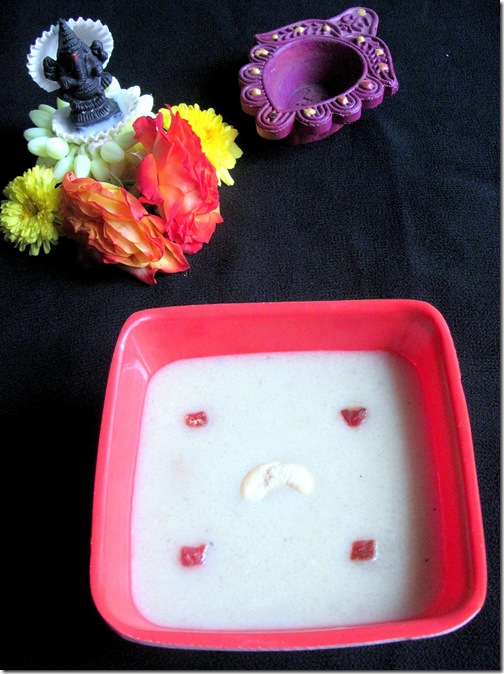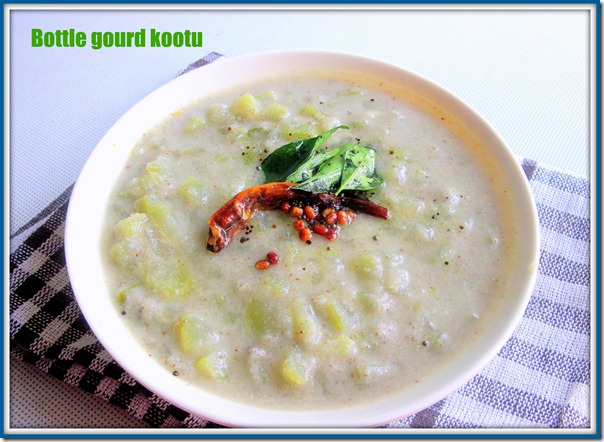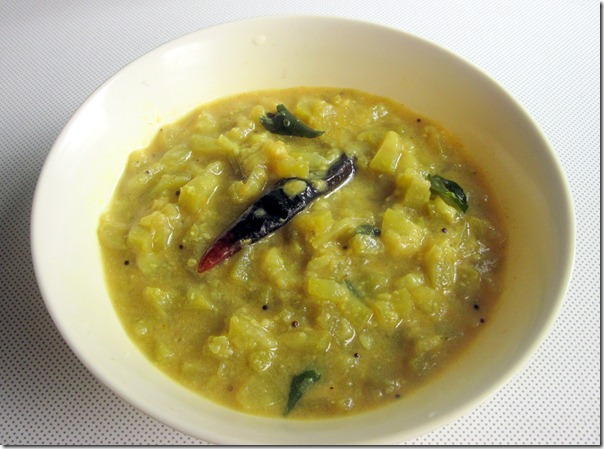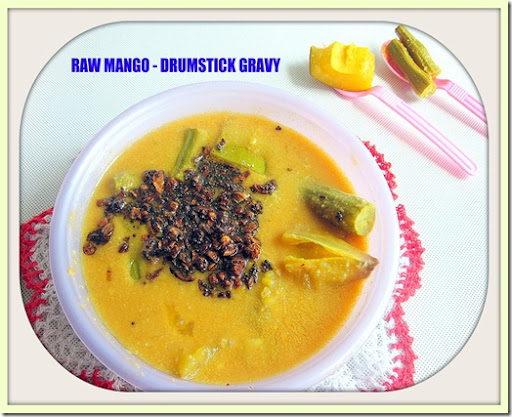miércoles, 30 de mayo de 2012
Green Chile Cheeseburger
http://feedproxy.google.com/~r/SpanishRecipesinpictures/~3/8FCESVbimro/chocolate-cookies.html
Get the rest in my blog! See you there!
jueves, 24 de mayo de 2012
Green Chile Cheeseburger
AVAL PAYASAM | RICE FLAKES PAYASAM

INGREDIENTS
- Thick rice flakes / poha/ Aval - 1 handful
- Powdered jaggery - 1/4 cup or little less
- Cardamom seeds - 2 nos (powdered)
- Ghee - 1 tsp
- Water - As reqd
- Roasted Cashews - a few
- Cloves /Krambu- 2 nos
- Roasted Nutmeg powder/ Jathikkai - A pinch
- Edible camphor / Pachai karpooram - a pinch
METHOD
- Heat a kadai with a tbsp of ghee and roast the cashews.Set aside
- In the same kadai, roast the aval and cardamom together for 3-4 mins. Aval becomes crispy and turns little brown.
- Allow it to cool. Powder it finely along with cardamom.
- Now take the water in a bowl and add the powdered aval.Cover and cook for 5 mins. Stir in between and check the water level.
- Add more water if needed. Now add the powdered jaggery and mix well.
- Allow it to boil for 5-10 mins. Finally add the roasted cashews. Add the items given under 'flavor' if necessary.
NOTE:
- U can add coconut milk for richness. But it should be added at the end before switching off the flame.
- If u feel sweetness is more, add little boiled milk.
- When u add milk along with jaggery , payasam gives a curdled look.To avoid this, add milk only at the end.
- If u want, u can replace jaggery with sugar.
- Here i've powdered the aval. If u wish, u can roast the aval and cook as it is. It will take little more time to cook.
lunes, 21 de mayo de 2012
Filled Chocolate Cupcakes - The recipes - revised January 2011
That's why you need a CD-rom cookbook (mine, of course). Because instead of having a cookbook that's covered in chocolate, you can have a few recipe pages that you've printed off, and when you're done, you toss the messy things out! But now, on to the recipe!
The Cake
The first time I made the cupcakes with Veronica and Jasmine (see Filled Chocolate Cupcakes, Part 1, I used a light version of my Chocolate Layer Cake. They were delicious, but a bit too tender. I think they were so tender because we used the maximum amount of milk (3/4 cup) and because we mixed them by hand. When I made them again, I used just a bit more than the minimum, and they came out much better - a little denser, which held up better for a pick-up type cake.
Makes 42 mini-cupcakes or 12 regular cupcakes
2-1/2 ounces semisweet chocolate, chopped
1 tablespoon oil
1 cup minus 1-1/2 TB (122 grams) bread flour, measured by fluffing, scooping and levelling*
2 tablespoons unsweetened cocoa powder
3/4 teaspoons baking soda
1/8 teaspoon salt
5 tablespoons (2.5 ounces) unsalted butter, cut into tablespoons and at room temperature
1/4 cup light brown sugar
1/2 cup sugar
1/2 teaspoon vanilla
2 large eggs, room temperature
1/4 cup + 2 tablespoons sour cream, room temperature
1/3 cup cup milk (skim or regular), room temperature
Preheat the oven to 350 degrees F. with an oven rack in the middle of the oven. Line muffin pans with liners.
You can see that they sort of pop up and don't stay down in the cups. Just give them a good shove from above, and let the sides pleat. When you add the batter, they will stay down.
Place the chopped chocolate and the oil in a microwave-safe container. Micro-cook on medium (#5) for 1 minute. Stir and then reheat in 15-second increments on medium power until the chocolate is melted.
In a small bowl sift together the flour, cocoa, baking soda and salt. Set it aside.
In a mixer bowl, combine the butter and both sugars. Beat on medium speed for 3-5 minutes until the mixture is uniformly smooth and creamy, and well aerated. Beat in vanilla. Add the eggs, beating for 1 minute after the addition of each egg, and scraping down the bowl a few times.
 On low, beat in the sour cream and chocolate. On low, in 4 additions, beat in the flour mixture alternately with the milk, starting and ending with the flour. (This is actually easier to do by hand, because the batter doesn't tend to separate when you do it by hand, but it does make the cake more tender when done by hand).
On low, beat in the sour cream and chocolate. On low, in 4 additions, beat in the flour mixture alternately with the milk, starting and ending with the flour. (This is actually easier to do by hand, because the batter doesn't tend to separate when you do it by hand, but it does make the cake more tender when done by hand).
Spoon the batter into the muffin cups, using one spoon to scoop up the batter and the other to push the batter into the pans. Fill the cups 1/2 to 3/4 full.
The Filling
I used whipped cream to fill the cherry-topped cupcakes, and Simple Vanilla Buttercream for the ones that look like Hostess cupcakes. The cream was easier to make, but the buttercream tasted far better. I've been making my buttercream a little thicker and sweeter lately, by adding a little powdered sugar to my basic recipe, but for this I wanted a filling that was very creamy - again so that it would be reminiscent of Hostess cupcakes. To do this, I used less than half of the powdered sugar as usual.
It's ultra important that the butter be at the right temperature for this recipe to work, AND THE ROOM! If the room is too hot, the buttercream will never form. The room should be no warmer than 74 degrees - and colder is even better.
To get the butter the right temperature, cut it into tablespoons and let it stand on a cutting board until barely soft. Using your thumb, push down on each pat to flatten it into the board (it will still be very firm, and will split when you press down on it). In 3-5 minutes the butter should be ready. If you press down on it with your thumb, it should yield readily, but should not be soft and melty. If the butter is a little firm, it can always be beaten a little bit more, but if too soft, you'll have to refrigerate it, and start over. I always aim for a little bit harder, rather than too soft.
2-1/2 sticks (20 tablespoons) unsalted butter, at cool room temperature
1 pound jar Marshmallow Fluff (this is a natural product containing only eggs, corn syrup and flavoring - so don't use another brand unless you check the ingredients)
1 teaspoon vanilla extract
2-3 tablespoons sifted powdered sugar
1-2 tablespoons corn syrup, to taste
2-3 tablespoons milk to soften the buttercream, optional
Now that the butter is at the proper temperature, scrape the butter into a mixing bowl and beat it until creamy (1 or 2 minutes.) Scrape down the bowl. Beat in the powdered sugar until fluffy. Add half of the Fluff, and beat on medium high until blended. Add the remaining Fluff, and continue to beat, on medium-high, for 2-5 minutes or until the frosting is fluffy and light and no longer marshmallowy.
This is what it should look like.
If the buttercream, does not form after beating for 5 minutes, place it in the refrigerator for 10 minutes, and then try and beat it again. After the buttercream forms, beat in the vanilla, corn syrup and milk, to taste.
 If you put a coupler in the pastry bag before filling it, you'll be able to try tips to find the one that works best with the size cupcake you are making. The piece on the left goes into the pastry bag, and then the tip gets put on, and the nut, in the center, keeps the pastry tip tight.
If you put a coupler in the pastry bag before filling it, you'll be able to try tips to find the one that works best with the size cupcake you are making. The piece on the left goes into the pastry bag, and then the tip gets put on, and the nut, in the center, keeps the pastry tip tight.Choose the tip that fits the size of the cupcake (I used Magic Tip #8 for filling, and Wilton #21 star for filling)
 Stick the tip into the bottom or top of the cupcake, depending on how you finish them (if you plan to add chocolate icing instead of having the frosting come out of the top, fill from the bottom, otherwise you will see the dimple where the frosting went in. It's easier to fill them from the top. For one thing, you don't have to take them out of the wrappers, which give some support to the cupcake so it doesn't split as you fill it. You can also feel when the cupcake is filled with the buttercream, and can stop before the cupcake starts to split.
Stick the tip into the bottom or top of the cupcake, depending on how you finish them (if you plan to add chocolate icing instead of having the frosting come out of the top, fill from the bottom, otherwise you will see the dimple where the frosting went in. It's easier to fill them from the top. For one thing, you don't have to take them out of the wrappers, which give some support to the cupcake so it doesn't split as you fill it. You can also feel when the cupcake is filled with the buttercream, and can stop before the cupcake starts to split.

You can see they look great with nothing more than some frosting coming out the top. But they're also fantastic, and look like mini Hostess cupcakes if you frost them with chocolate icing and vanilla icing decoration.
Sift the powdered sugar into a small bowl. Stir the chocolate into the powdered sugar. Stir in half of the hot water. The mixture should be thin enough to fall off of the spoon in a steady stream. If it isn't, add the remaining hot water, 1/2 teaspoon at a time.
Vanilla Glaze
Hold the bag closed at the top, with the filled part resting in your palm, and your thumb and index finger holding the top (you can put a rubber band around the top if it is easier). Gently squeeze the filling toward the tip. Make a very tiny cut in the tip with scissors. Pipe on the decoration, and then refrigerate until 30 minutes before serving.

More Observations on the Hunger Challenge
Yesterday's post was the most pitiful thing I think I've ever written. I tried a new recipe, Queso Panela Kebabs, and it was a failure. The cheese melted into a sad pile of goo. Failure happens but it's all the more discouraging when you're on a budget. It's not like you can run out and buy more ingredients. Also, you can probably tell, my heart just wasn't in it. I was feeling uninspired and that always comes across when I'm cooking (and writing). So I made a dull meal lacking any real creativity. It makes me embarrassed to read that post. But my embarrassment is nothing compared to the feelings that someone really living on a limited budget would experience.
There has been some criticism of the Hunger Challenge specifically from people who have experienced real hardship, some of whom have been on public assistance. I can completely understand why they would not want to participate and would feel uneasy with the Hunger Challenge. If I experienced real hunger I would not want to relive it or even be reminded of it. The Hunger Challenge is about the experience of living on a very limited budget. It is NOT an attempt to fully experience what someone actually living on a food stamps budget experiences, because that would be impossible.
In the future I hope the Hunger Challenge will make room at the table for those in our midst who have experienced hunger. I'd like to see a space for those who are willing to share their stories, like KitchenMage. Painful as it may be, those stories are more powerful than anything we who are taking the Hunger Challenge could ever share. Like the Hunger Challengers they raise awareness about hunger and also inspire readers to make donations. And really, no matter what we do, that's what it's all about.
Ways you can help
♥ Read blogs by people taking the Hunger Challenge. There's a blogroll here.
♥ Follow the Hunger Challengers on Twitter. There's a listing here, or search for the hashtag #HungerChallenge.
♥ Learn more about the San Francisco Food Bank - and make a donation. For every $1 donated the food bank can supply hungry people with $6 worth of food!
♥ Follow the San Francisco Food Bank on Twitter or visit their Facebook page to see how they're fighting hunger every day.
domingo, 20 de mayo de 2012
SORAKKAI SWEET KOOTU & PAAL KOOTU/ BOTTLE GOURD GRAVY- TWO VERSIONS
I learnt this from my MIL.. We are not find of this vegetable. So i buy bottle gourd very rarely. But whenever i buy , i make only this kootu. With vathakuzhambu , it tastes divine… I've given a spicy version too. But my vote goes to the sweet version
Love it a lot..!!
INGREDIENTS
To grind
To temper
Milk (optional) at the end .. |
METHOD
|
Enjoy with Vathakulambu rice and papad !!
SORAKKAI PAAL KOOTU
To grind
To temper
MILK – LITTLE AT THE END |
METHOD
Enjoy with rice and papad ! |
KITCHEN CLINIC
| Bottle gourd The bottlegourd belongs to the cucumber family and originated in Africa, and is now available in most parts of the world. Also known as calabash, cucuzza, sorakaya, lauki, doodhi, and ghiya in various languages, this vegetable comes in different shapes, the most common being the bottle-shaped (hence the name) and round. HEALTH BENEFITS Bottlegourd contains a lot of water - almost 96 percent is water, and as such is light and easy to digest. Bottlegourd is commonly used for treating indigestion, constipation, and diarrhea. Bottlegourd juice with a pinch of salt is also used to treat dehydration caused by diarrhea. Cooking Tips
|
RAW MANGO - DRUMSTICK GRAVY| PORICHA KUZHAMBU
I learnt this from my MIL. Usually we make this gravy only with drumstick. But during mango season , we make this combination. It tastes great with the excellent flavor of mango. If u don't get sour raw mango ,no problem , u can try this with drumstick alone by adding little tamarind extract to get the tangy taste. We mix this gravy in plain rice with little ghee.Here i've used Vengaaya vadagam for seasoning.I think most of u may not have/aware of this. So i've given the ingredients below to replace vadagam.
Try this simple & delicious poricha kuzhambu. Iam sure u'll love it and start to make it often.
INGREDIENTS
- Raw mango - 1 no ( Medium sized) (cut into cubes as shown in the above picture)
- Drumstick - 2 nos
- Moong dal - 2 tbsp
- Sambhar powder - 1.5 - 2 tsp
- Salt & water- As needed
To grind:
- Grated coconut - 2 tbsp
- Water - As needed.
To temper:( to replace vadagam)
- Mustard seeds - 1/4 tsp
- Urad dal - 1/4 tsp
- Jeera - 1/4 tsp
- Small onion - 10 nos ( cut into small pieces)
- Curry leaves - a few (finely chopped)
- Cooking oil - 1 tbsp
METHOD:
- Pressure cook moong dal by adding a pinch of turmeric powder and a drop of oil. Mash it and set aside.
- Now in a bowl , take the drumstick pieces.Add the required water & cover cook. When it is half cooked, add the cubed mango pieces and add more water if necessary. Once it starts to boil , add the sambhar powder, salt & cooked moong dal. Cover cook till mangoes & drumstick pieces get cooked.{Make sure the mango pieces should not be mushy and dissolved in the gravy}.
- Now grind the grated coconut adding little water to make a smooth paste.
- Mix this paste to the gravy and allow it to boil for sometime. If u feel the gravy is too thick, add water to bring the consistency. (In this step , check the salt & spice, add if needed)
- Suppose if the gravy is too watery after adding the coconut paste , u can add a little amount of rice flour to make the gravy thick.But this step is purely optional.
- At last , season the gravy with vengaaya vadagam or the above mentioned items. If u use the above said items for tempering, saute till everything turns brown. This gives a spl flavor to the gravy.
ENJOY MIXNG WITH HOT PLAIN RICE & A DROP OF GHEE OR SERVE AS A SIDE DISH FOR VATRAL KUZHAMBU / SAMBHAR RICE.
KITCHEN CLINIC:
| DRUMSTICK All parts of drumstick tree are useful and have long been used for nutritional, medicinal, and industrial purposes. The drumstick pods or fruits are used as a vegetable in curries and soups and very popular in Indian food. Crushed drumstick leaves are used as a domestic cleaning agent; powdered seeds are used for clarifying honey and sugarcane juice, and for purifying water. Moringa seeds produce oil, also known as Ben oil, which is a sweet non-sticky oil that doesn't become rancid. This oil is used in salads, for lubricating machines, and in perfumes and hair-care products. Drumstick and HealthQuick FactsAlmost all parts of the drumstick tree have medicinal value. The small, round leaves are especially beneficial in treating many ailments because of their high iron content and many medicinal properties. Drumstick leaves can be eaten fresh, cooked, or stored as dried powder for many months without refrigeration, and reportedly without loss of nutritional value. Where starvation is imminent, consuming the drumstick-leaf powder can be life-saving. According to the Trees for Life organization, "ounce-for-ounce, Moringa leaves contain more Vitamin A than carrots, more calcium than milk, more iron than spinach, more Vitamin C than oranges, and more potassium than bananas," and that the protein quality of Moringa leaves rivals that of milk and eggs. Because of the high calcium, iron, and vitamins, drumstick leaves can be used as a wonderful tonic for infant and growing kids and teens to promote strong and healthy bones and for purifying the bloodstream. To prepare the tonic, drumstick leaves should be ground with water, filtered, and mixed with milk. Drumstick-leaf juice is also very beneficial for pregnant women as it can help them overcome sluggishness of the uterus, ease delivery, and reduce post-delivery complications. In India, drumstick leaves are boiled in water and salt, the water is drained, and the leaves are served with ghee (clarified butter) to lactating mothers to increase breast milk. Drumstick leaves are very useful in treating wheezing, asthma, bronchitis, and tuberculosis. A soup prepared by boiling a handful of leaves in 3/4 cup water for 5 minutes and cooled is served to those with respiratory problems. A little salt, pepper, and lime juice can be added to this soup. Drumstick has antibacterial properties and as such is very useful in preventing infections such as those of the throat, chest, and skin. Drumstick soup can be prepared from the leaves, flowers, and pods and used for this purpose as an antibiotic. Dried and powdered bark of the drumstick root can also be used for fungal skin infections. Drumstick leaves, flowers, and seeds are useful in treating sexual debility and weakness. A teaspoonful of fresh drumstick-leaf juice mixed with honey and a glass of tender coconut water taken 2-3 times a day is a wonderful remedy for digestive disorders like diarrhea, dysentery, colitis, jaundice, and cholera. Drumstick-leaf juice is also effective in treating urinary disorders such as excessive urination. Drumstick-seed oil is useful in treating conjunctivitis. Fresh drumstick-leaf juice mixed with lime juice can also be applied to treat pimples, acne, and blackheads. |















